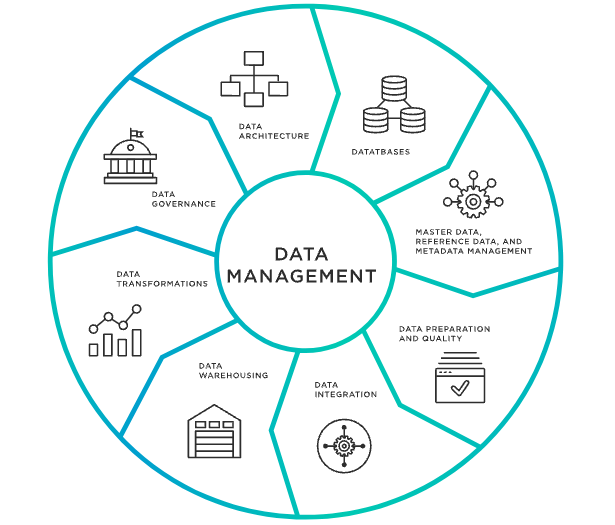Exploring the types of data management is essential for businesses and IT departments aiming to navigate the complexities of today’s data-driven landscape.
Exploration of the types of data management will set the stage for understanding how data can be effectively harnessed, analyzed, and protected to drive decision-making and innovation.
Recent insights from the EDM Council’s 2023 Global Data Management Benchmark Report reveal a growing recognition of data management’s strategic importance.
This report shows an increase in the formal appointment of Chief Data Officers, indicating an organizational commitment to improving data management practices.
Moreover, a survey conducted by MIT Sloan highlights the shifting priorities and challenges faced by data professionals, emphasizing the significance of data governance, building a data-driven culture, and deriving value from data.
These findings underscore the necessity of adopting a comprehensive approach to data management, which includes developing robust governance frameworks, ensuring data quality, and fostering a culture that values data-driven insights.
Your business needs to explore different data management strategies that meet your unique needs and goals to navigate this complex landscape. Let’s delve into the details of these strategies.
1. Centralized Data Management
Centralized data management refers to storing and managing all organizational data in a single, central repository.
This approach enables streamlined data management processes, facilitating easy organization, updates, and maintenance of data integrity.
A central data repository enhances comprehensive data analysis, allowing businesses to derive meaningful insights and make data-driven decisions more efficiently.
Additionally, centralized data benefits from robust security measures, making implementing stringent access controls and encryption mechanisms easier to reduce the risk of unauthorized data breaches.
One of the primary concerns in data management is the creation of data silos, where different departments or teams within an organization might hoard data, hindering cross-functional collaboration and diminishing the potential for holistic insights.
Another significant challenge is the risk of a single point of failure; if the centralized system encounters issues, it can significantly disrupt operations and potentially compromise the entire dataset.
Moreover, centralized data raises privacy concerns, especially when dealing with sensitive user or customer information, requiring organizations to implement robust privacy protocols to ensure compliance with data protection regulations.
Despite these challenges, the advantages of centralized data management, such as efficient data management, improved data analysis, and enhanced security, underscore its importance in today’s data-driven landscape.
When considering centralized data management, your business must weigh these benefits against the potential drawbacks to determine if this approach aligns with its data management strategy and business goals.
2. Decentralized Data Management
Decentralized data management is the distribution of data across multiple locations or systems rather than maintaining it within a single, central repository.
This approach fosters autonomy by empowering individuals or departments within an organization to own and manage their data, tailoring data management practices to specific needs.
It is particularly effective when enhanced data ownership, scalability, and resilience are crucial.
Decentralized systems are inherently scalable, allowing your businesses to:
- Expand their operations without the constraints of centralized infrastructure
- Provide resilience against system failures, ensuring business continuity and data availability.
In managing data for a small business, decentralized data management can offer flexibility and agility.
Small businesses can benefit from decentralized systems by distributing their data across various nodes, making the system more adaptable to changes and growth.
This setup can mitigate risks associated with data centralization, such as a single point of failure, and enhance data security by distributing data storage and processing.
Challenges such as ensuring data consistency, complex data integration, and increased security risks must be addressed.
3. Cloud-Based Data Management
Cloud-based data management represents a transformative approach to handling data by leveraging cloud platforms for storage, analysis, and processing.
This methodology capitalizes on the cloud’s scalability, flexibility, and cost-effectiveness to efficiently manage vast volumes of data.
A Global Cloud-based Data Management Services Market Report in ResearchAndMarkets.com’s offering reveals the global market for cloud-based data management services is projected to grow from USD 40.2 billion in 2023 to USD 141.7 billion by 2028.
The number emphasizes the increasing reliance on cloud solutions for data handling needs.
The benefits of adopting cloud-based data management include:
- Improved scalability that accommodates business growth without significant hardware investments
- Enhanced data accessibility that facilitates remote work and global collaboration
- Cost savings through pay-as-you-go pricing models.
Despite these advantages, your business must consider challenges such as data security concerns, compliance with data protection regulations, and the potential for increased complexity in managing cloud environments.
A 2023 report by Flexera on cloud usage among 750 decision-makers highlights that organizations are increasingly adopting multi-cloud strategies to leverage the strengths of different cloud providers.
This shift underscores the need for a comprehensive approach to cloud-based data management that addresses security, cost control, and the technical challenges of operating across multiple cloud platforms.
4. Database Management Systems (DBMS)
The role of Database Management Systems (DBMS) in data management is storing, organizing, accessing, and analyzing data efficiently.
DBMS utilizes structured models, often through tables comprising rows and columns, to facilitate data processing and querying.
This structure ensures easy management, modification, and updating of information as needed.
Popular types of DBMS include relational, NoSQL, and NewSQL databases, each catering to different data management needs.
For instance, relational databases like MySQL, PostgreSQL, and Microsoft SQL Server are widely used for their robust data integrity and transaction support.
PostgreSQL, known for its open-source nature, is highly regarded among professionals for its advanced features and compliance with SQL standards.
The choice of a DBMS largely depends on specific project requirements, including data complexity, scalability needs, and budget constraints.
With advancements in cloud computing and data science, choosing the right DBMS can significantly impact an organization’s ability to harness data effectively for strategic decisions.
5. Master Data Management (MDM)
Master Data Management (MDM) in the data management process ensures the uniformity, accuracy, and accountability of an organization’s core business data.
MDM is instrumental in eliminating redundant and inconsistent versions of the same data in an organization.
MDM encompasses the methods, tools, and processes used to manage, centralize, organize, categorize, localize, synchronize, and enrich master data according to the business rules of the company’s sales, marketing, and operational strategies.
Master data includes key business entities such as customers, products, employees, and suppliers.
The significance of MDM has grown with the advent of complex data landscapes characterized by data silos and inconsistencies that can hinder operational efficiency and decision-making.
For example, in the BFSI (Banking, Financial Services, and Insurance) sector, MDM helps aggregate information from disparate sources to create a single source of truth for customer and transaction data.
This unified view enables BFSI institutions to offer personalized services, comply with regulatory requirements, and enhance risk management.
Similarly, in retail, MDM can unify product data across multiple channels, ensuring consistency in product information, which is vital for providing a seamless customer experience.
The future of MDM is expected to be shaped by several key trends, including the shift towards cloud-based solutions, the integration of Artificial Intelligence (AI) and Machine Learning (ML) for improved data quality and governance, and a focus on real-time data processing.

6. Big Data Management
This big data management addresses the challenges of storing, processing, and analyzing large datasets to extract valuable insights, which are crucial for decision-making and strategic planning.
Handling big data comes with several challenges, including the need for skilled data professionals, the complexity of integrating data from diverse sources, and securing vast datasets.
The lack of knowledge professionals is a significant barrier, as companies require data scientists, analysts, and engineers to manage and interpret big data effectively.
The rapid evolution of data handling tools has outpaced the availability of skilled professionals, creating a gap that organizations strive to bridge through recruitment, training, and adopting AI/ML-powered analytics tools.
Ensuring data governance and security is another critical aspect of big data management.
Your business must classify data based on sensitivity, apply appropriate access controls, and adhere to data protection regulations to protect consumer privacy and avoid legal consequences.
Data encryption, de-identification, and regular audits are among the practices to maintain data security and privacy.
Solutions, including the implementation of advanced data management technologies, have been proposed to address these challenges, such as”
- Hadoop for distributed storage and processing,
- NoSQL databases for handling unstructured and semi-structured data,
- Cloud-based platforms for scalable and flexible data storage and analysis.
Cloud-based solutions, in particular, have gained popularity due to their cost-effectiveness, scalability, and the ability to access data remotely.
The future trends in big data management highlight a growing emphasis on cloud-based solutions, the integration of artificial intelligence and machine learning technologies, and the automation of data governance processes.
7. Data Governance
Data governance focuses on establishing clear policies and standards for data usage to ensure data quality and compliance with regulations.
Data governance becomes crucial in a world where data drives decisions, impacting everything from strategic business moves to everyday operations.
In 2024, cloud data governance emerged as a key trend, highlighting the shift towards leveraging cloud technologies for managing data more efficiently.
According to a 2021 Gartner article, more than 70% of organizations have started migrating workloads to the public cloud due to the advantages of scalability, flexibility, and on-demand data access.
However, this transition introduces challenges such as budget overspends and migration delays, underscoring the need for robust data governance frameworks that can adapt to cloud-based environments.
Data governance in 2024 will also significantly emphasize data access governance and democratization.
With the rising need for compliance with global data protection regulations, businesses are focusing on granting data access more strategically.
The main objective is to ensure data is available to those needing it while maintaining stringent security measures.
As data governance continues to evolve, adopting a service-oriented approach is a strategic move for many organizations, including your business.
This approach prioritizes flexibility, empowers data stewards, and enhances metadata management, enabling businesses to adapt to increasing data regulations and compliance requirements.
8. Data Security and Privacy Management
Data security and privacy management focus on protecting data integrity and complying with regulatory standards.
Yes, your business must prioritize robust data management strategies to safeguard sensitive information and maintain trust with stakeholders as privacy laws evolve and cybersecurity threats grow more sophisticated.
The significance of managing data security and privacy has never been greater, particularly with the introduction and enforcement of regulations like the General Data Protection Regulation (GDPR) in the EU.
One approach to ensuring data security and privacy is to adopt comprehensive measures such as encryption, access control, and regular security audits to prevent data breaches.
Furthermore, organizations must remain alert to the constantly evolving cybersecurity threats and utilize advanced technologies such as biometric authentication and cloud computing controls to protect sensitive information.
Compliance with regulations such as GDPR necessitates a proactive approach to data privacy.
The proactive approach involves implementing policies for data processing and transfer, obtaining explicit consent from individuals, and ensuring the right to data portability and erasure.
Your company must navigate these complex legal landscapes by updating privacy policies, conducting regular data mapping to understand data practices, and developing systems to process data privacy rights requests.
Conclusion
Let’s wrap up our deep dive into data management with some exciting insights.
Riding the wave of data-driven strategies isn’t just the latest trend; it’s the backbone of smashing your business goals.
Navigating this complex world requires a solid game plan, from rock-solid centralized systems to super-flexible cloud solutions. And guess what? That’s where we, the Nexalab, come into play.
We’re here to smooth the rough seas of data storage, analysis, and security for you, enabling strategic decision-making and growth that’ll take your business to new heights.
Picture this: interactive dashboards that tell your business story at a glance, seamless data integration, and ETL workflows designed just for you.
Collaborating with us will provide you with the latest technology and know-how, ensuring your data strategies are GDPR-friendly and supercharged for efficiency and scalability.
Choosing Nexalab provides various types of data management superpowers for innovation, security, and a serious competitive edge.




